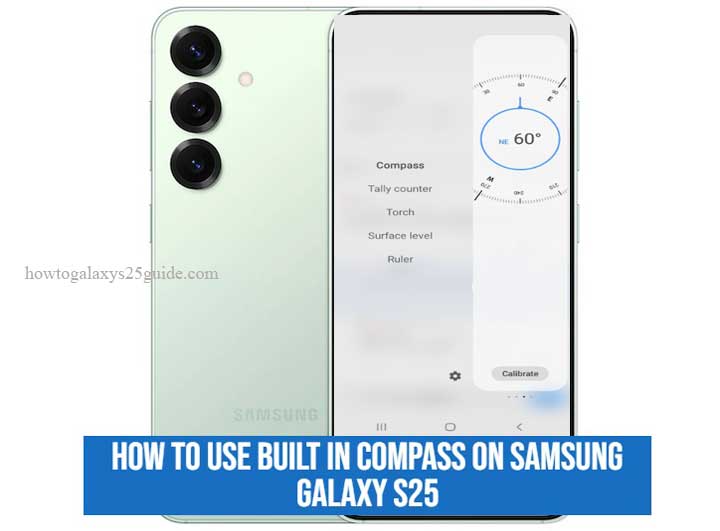
The Samsung Galaxy S25 comes with advanced sensors that enhance its navigation and outdoor capabilities. Among them, the built-in compass is one of the most practical tools, helping you determine direction even when you’re offline or without GPS signal. This guide explains how to use the built-in compass on the Samsung Galaxy S25, how to calibrate it for accuracy, and how to troubleshoot common issues.
What the Built-In Compass Does
The compass on your Galaxy S25 works through a magnetometer, a tiny sensor that detects the Earth’s magnetic field. When combined with the accelerometer and GPS, it allows your phone to determine its orientation — north, south, east, and west.
This feature is especially useful when:
- Navigating using offline maps
- Orienting your position during hiking or travel
- Aligning AR (Augmented Reality) apps
- Checking directions quickly without opening a full navigation app
Unlike external compass apps that rely on software emulation, the Galaxy S25’s built-in compass provides hardware-level magnetic readings, ensuring more precise results.
How to Find the Compass on Samsung Galaxy S25
Samsung integrates the compass feature into the Edge panel under the Quick Tools or Tools section. To access it:
- Swipe from the side of the screen to open the Edge panel.
- Swipe through the panels until you find Tools or Quick Tools.
- Tap Compass to launch it.
If the Tools panel doesn’t appear, you may need to enable it:
- Open Settings > Display > Edge panels.
- Turn on Edge panels and select Panels.
- Activate Tools or Quick Tools in the list.
Once enabled, you can access the compass anytime by swiping in from the screen edge. The display will show the direction, degrees, and sometimes altitude or coordinates depending on your One UI version.
How to Use and Calibrate the Compass
Before relying on your compass for navigation, it’s best to calibrate it. Calibration ensures the magnetometer reads the Earth’s magnetic field correctly, free from interference caused by nearby objects or magnetic cases.
Calibration Steps
- Open the Compass via Edge panel or Tools.
- Hold your phone flat in your hand, facing upward.
- Move the phone in a figure-eight motion several times until the compass responds smoothly.
- Wait for an on-screen prompt confirming calibration.
If you’re using Google Maps, you can also calibrate through it. Simply open Maps, tap your blue location dot, and follow the “Calibrate compass” option. The principle is the same — moving your device in a figure-eight pattern allows the sensors to align accurately.
Why Calibration Matters
Magnetometers are sensitive to surrounding magnetic fields. When exposed to metal surfaces, magnets, or wireless chargers, the compass can drift and give incorrect readings. Regular calibration ensures accuracy, especially after:
- Restarting the device
- Installing new system updates
- Traveling long distances
- Using a magnetic phone case or holder
According to research on magnetometer performance published by the University of California, accurate compass readings depend on eliminating magnetic interference and maintaining regular recalibration for environmental changes. This aligns with Samsung’s own support guidelines, which recommend recalibration when the compass direction appears off.
Troubleshooting Common Compass Issues
Sometimes, the compass may not appear, or it may give unstable readings. Here are the most effective fixes:
1. Enable Location Services
Although the compass works without GPS, having Location turned on improves accuracy. Go to Settings > Location and ensure it’s enabled.
2. Remove Magnetic Interference
Avoid using your phone near metal surfaces, speakers, or magnetic cases. These can distort magnetic sensor readings.
3. Recalibrate Frequently
If your compass constantly prompts for calibration or points incorrectly, repeat the figure-eight motion until stable.
4. Restart or Test the Sensor
Restart the phone to refresh sensor data. On some Samsung devices, you can test the magnetometer by dialing *#0*# and selecting Sensors > Magnetic Sensor. If the self-test fails, the magnetometer might need servicing.
5. Software Updates
Keep your One UI and firmware updated, since sensor calibration algorithms often improve in newer versions.
6. Hardware Check
If your compass remains inaccurate despite all fixes, the magnetometer might be damaged. Visit a Samsung service center for a diagnostic test.
Best Practices for Accurate Results
- Use the compass outdoors or away from heavy electronic interference.
- Keep your phone level and flat when checking direction.
- Recalibrate every few days or after a long trip.
- Avoid magnetic phone accessories when using navigation tools.
- Cross-check direction with GPS apps like Google Maps for confirmation.
These habits ensure your Galaxy S25’s compass remains reliable in different environments.
Conclusion
The built-in compass on the Samsung Galaxy S25 is a reliable navigation tool powered by the phone’s magnetometer. By accessing it through the Edge panel, calibrating it regularly, and avoiding magnetic interference, users can ensure accurate direction readings anytime, anywhere.